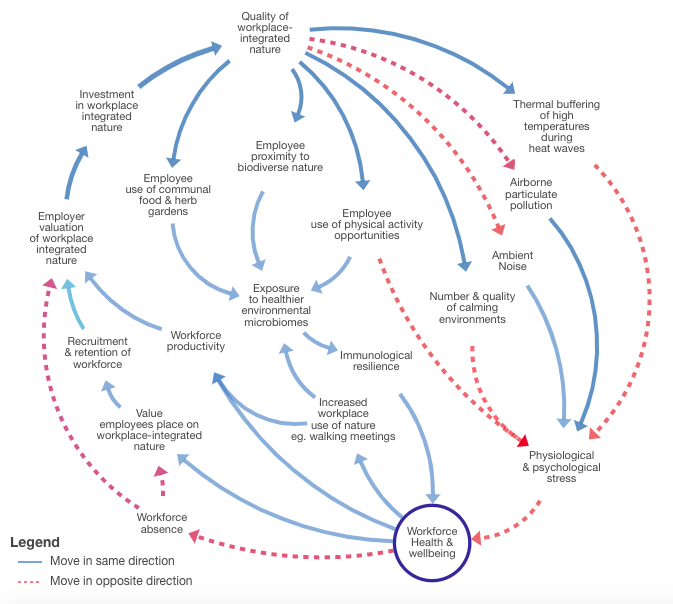City Know-hows

Target audience
Urban planners, public health professionals, property management professionals
The problem
Increasing urbanisation in the developed world has been linked to a concomitant rise in non-communicable disease. Despite this, research suggests we can intervene by improving access to, and the quality of surrounding nature in order to improve health and wellbeing.
As work commitments often limit people spending more time in nature, we explore whether bringing more nature into our workplaces could positively influence the health and wellbeing of employees and the local population.
What we did and why
We explore the health benefits of being ‘in nature’, the barriers and benefits of bringing ‘nature’ into the workplace, and whether workplace nature-based solutions could improve the health and wellbeing of the workforce. We focused on ‘workplace-integrated nature-based solutions’ because of the well-established link between nature and health and the additional benefits this has in improving climate resilience of communities.
Our study’s contribution
The literature we have reviewed suggests that the expected outcomes from pursuing nature-based solutions in the workplace include:
In addition to recommending key areas for future research, we have identified 18 perceived or real barriers that need to be addressed in the process of improving the integration of nature into the workplace.
We encourage employers to extend this method in order to develop a shared understanding of barriers specific to your workplace and to work on systemic solutions that work for you in your setting.
Impacts for city policy and practice
Our findings are relevant to several city-wide processes; including office district planning, policy around building approvals, policy-relevant to street furniture, greenspace policy and policy about active travel and access to greenspace.
Further information
Healthy Urban Microbiome Initiative; understanding the hidden value of nature in urban environments.
Resilience Frontiers Programme, UNFCCC; understanding why bringing nature into our cities is the future of resilient urban environments.
C40 Cities; understanding what the major cities of the work think is the future.
Full research article:
Integrating nature and workplaces in a post-COVID-19 world: building back better by Jennifer Allen, Rupert Lloyd & Chris Skelly
Related posts

Extreme heat and wildfire smoke are a growing concern in cities. Cooling and cleaner air centres can provide a much-needed respite but too often they’re set up reactively and inconsistently. Our study explores what works, what doesn’t, and how cities can design these spaces to be reliable, inclusive, and accessible for all.

Public health has historically been an important factor driving urban planning policy in England but is currently rarely a priority. We explore the factors behind this, try to explain them in the context of policy developments since COVID-19, and consider what needs to change at national policy level to support healthier placemaking in the future.

Poorly designed neighbourhood outdoor spaces can harm citizens’ mental health, such as presenting them with information overload, crowding or low exposure to nature. Our research explored which design elements can support urban designers in designing neighbourhood outdoor spaces that can reduce stress and attention fatigue and improve the mental health of all citizens.